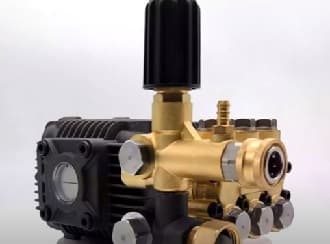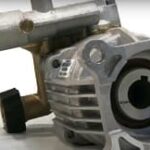As an Amazon Associate, this site earns commissions from qualifying purchases. For more information click here.
The pump is what makes a pressure washer a superb cleaning tool. The engine provides the power but the pump is what allows water to flow. if you want to know how pressure washer pumps work, you are in the right place.
A pressure washer pump makes the crankshaft move back and forth, drawing the plunger upwards. A valve opens, water flows and the valve closes. The plunger goes down, a discharge valve open and water goes through the spray nozzle.
How a Pressure Washer Pump Works
The engine powers the pressure washer pump while a crankshaft moves the connecting rods back and forth. The plungers are in the cylinders, which are contained in plunger guides. These guides are linked to the connecting rods.
When you turn on a pressure washer, the engine runs and the crankshaft starts rotating.
As the crankshaft moves, the plunger gets pulled up. At the same time the inlet valve opens, releasing water into the manifold.
The valve closes and the plunger begins moving down. This causes the discharge valve to open up and water gushes through and out of the pressure washer nozzle.
This video explains the process.
Types of Pressure Washer Pumps
Pressure washers use reciprocating pumps and are driven by plungers or pistons. Plunger pumps make up most commercially available pressure washers. The Westinghouse WPX3200, one of the best pressure washers out there, is a good example of this.
There are four types of piston/plunger pumps:
- Axial cam and wobble pumps, used with pistons
- Duplex or triplex pumps which rely on crankshafts
Majority of pressure washers use duplex or triplex plunger pumps. Plunger pumps are more efficient than piston pumps and last longer. While piston pumps have good priming properties, they cannot withstand high pressure, which makes them impractical for pressure washers.
Pressure washer pump speed determines capacity, which is why you must only use a pump that is compatible with your pressure washer. The water volume that comes in and out must be the same. That’s the reason why pressure washers have safety pressure and unloader valves built in.
Now let’s take a look at the three types of pressure washer pumps: wobble, axial cam and duplex/triplex.
Wobble Plate Pumps
Wobble plate pumps are sometimes used in light powered pressure washers (2500 PSI, 2 GPM and below).
The plate is hooked up to the drive shaft which moves the pistons up and down. This generates suction and releases water.
These pressure washer pumps have a spring which enables the wobble plates to move the pistons. Because the plate has to constantly push, pressure washer efficiency is only at 70-75%.
Wobble plate pumps are made up of many complex components. These are factory sealed so repair is almost impossible. Add the low efficiency rate and it’s easy to see why high end pressure washers don’t use it.
Wobble plate pumps can generate high pressure, but flow is limited and has too many limitations. A typical wobble plate pump lasts for 2-3 years, assuming it is used 3 hours a week.
Axial Cam Pumps
Also known as swash plate pumps, axial cam pumps are used in 3500 PSI and lower pressure washers.
Its mechanism is similar to wobble plates, except the pistons spin around the plate. As the pistons move one side, water is drawn up and then pushed out. It is linked to the drive shaft and moves in a similar axis.
Axial cam pressure washer pumps can accommodate large bearings and sizeable oil tanks, which makes pressure washers last longer. Most axial cam pumps are good for 5-6 years. This assumes usage of around 3 hours weekly.
By changing the angle of the plate you can adjust the flow. It has a higher efficiency rate than wobble plates and better performance.
One drawback with axial cam pumps is it takes a long time to cool. This is because the system operates at high speed.
Its cylinder seals are right on the piston head which can cause it to break down with heavy use.
Duplex/Triplex Pumps
These are crankshaft driven pumps and are the standard used by powerful pressure washers. Crankshaft pumps can withstand high pressure and designed to run for thousands of hours.
Triplex pumps are more powerful than duplex which is why they’re the standard. Duplex pumps generate higher pulses and put greater stress on the engine. You also need to install an accumulator to minimize vibration.
Basically a triplex pressure washer pump uses connecting rods and a crankshaft to draw water in and out with every stroke.
Triplex pumps have a 90% or higher efficiency. The pump is slower than the engine so it doesn’t get as hot as an axial cam.
Triplex crankshaft pumps last at least 10 times longer than an axial cam. Properly maintained these pumps endure even longer.
Aside from their durability, the valves and pump head are very accessible. In case you need to make a replacement it is straightforward.
I also want to point out that triplex pump seals are stationary. This makes the system less vulnerable to leaks. It also allows the pump to withstand high pressure.
If you are buying a 3000 PSI or higher pressure washer like the Simpson PS60869, chances are it uses triplex pumps. It is a very efficient, long lasting design and well worth it.
How Reliable are Pressure Washer Pumps?
Pressure washer pumps have improved a lot over the years. Quality pressure washers have high speed pumps built in that demand less torque to start. These systems are also less likely to suffer from pressure fluctuations and pulses.
Based on personal experience, I have to say not all pressure washer pumps are created equal. Some are more reliable than others. A poorly designed pump wears out quickly and often has poor suction power.
Even the best pressure washer pumps can succumb to failure though. One of the most common reasons pumps fail is lack of water. if there’s not enough water in the pump, the system won’t function properly.
Regular pressure washer maintenance is the key making it last. Follow the instructions in your user manual and the pump should be fine.

What to Look For in a Pressure Washer Pump
Look for a pump that has the same PSI and GPS as the current one. A higher PSI or GPS could damage the pressure washer, so the new pump must have the same specs.
If your pressure washer has a triplex or axial pump, replacing it is straightforward. These pumps, triplex in particular, are designed to run for thousands of hours so you don’t have to worry about wear and tear anytime soon.
If you do need a replacement, check what kind of pump your pressure washer has. You can find this in the owner’s manual or the manufacturer website.
If you lost the manual and can’t go online, look at the pump. If the driveshaft is parallel to the valve, you have a triplex. If it is pointed at the valves, that is an axial cam.
As I pointed out earlier, triplex pumps are often found on powerful pressure washers, while axial pumps are more common on entry and intermediate levels. But it’s best to check the manual or the pump design to be sure.
Once you have determined the type, measure the shaft diameter and if it is hollow or not. Look also if the motor is shafted vertically or horizontally.
if the driveshaft is vertical, the pump will be under the engine. If the driveshaft is horizontal, the pump is adjacent to the engine.
How to Install a New Pressure Washer Pump
Turn the pressure washer off if you haven’t done so already. Pull the spark plug wire off and all hoses connected to the pressure washer.
How many hoses you have to disconnect depends on its configuration. Usually there is at least three: the chemical injection tube, outlet and inlet hose.
Disconnect any other components on the pressure washer. Now you can take the pump out. Remove the screws or bolts with an Allen wrench.
Once the bolts loosen, hold the pump with one hand. Use your other hand to remove the bolts. Pull the pump off.
Check if your new pressure washer pump comes with a thermal relief valve. Most do but if yours does not, remove the thermal relief valve on the old pump and put it on the new one
The last step is to install the new pump. Clean the mounting area first and put the pump in place. Hold it with one hand and put the bolts back on with the other.
Reconnect the hoses and spark plug wire. Turn the pressure washer on and test it. You might have to adjust some settings to get it to work the way you want.

I love the outdoors and all the tools for maintaining gardens, yards and lawns. The only thing I am more passionate about is sharing what I know about garden and outdoor equipment.


